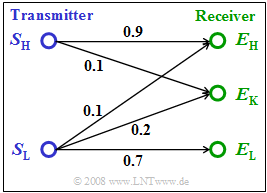A transmitter (German: "Sender" ⇒ subscript "S") emits the binary symbols $\rm L$ $($event $S_{\rm L})$ and $\rm H$ $($event $S_{\rm H})$ .
- If conditions are good, the digital receiver (German: "Empfänger" ⇒ subscript "E") also decides only on the binary symbols $\rm L$ $($event $E_{\rm L})$ or $\rm H$ $($event $E_{\rm H})$.
- However, if the receiver can suspect that an error has occurred during transmission, it makes no decision $($event $E_{\rm K})$;
$\rm K$ here stands for "No decision".
The diagram shows a simple channel model in terms of transition probabilities.
- It can be seen that a transmitted $\rm L$ may well be received as a symbol $\rm H$.
- In contrast, the transition from $\rm H$ to $\rm L$ is not possible.
- Let the symbol probabilities at the transmitter be ${\rm Pr}(S_{\rm L}) = 0.3$ and ${\rm Pr}(S_{\rm H}) = 0.7$.
Hints:
- The exercise belongs to the chapter Statistical dependence and independence.
- The topic of this chapter is illustrated with examples in the (German language) learning video
- Statistische Abhängigkeit und Unabhängigkeit $\Rightarrow$ "Statistical dependence and independence".
Questions
Solution
(1) Only if the symbol $\rm L$ was sent, the receiver can decide for the symbol $\rm L$ at the given channel.
- However, the probability for a received $\rm L$ is smaller by a factor of $0.7$ than for a sent one. From this follows:
- $${\rm Pr} (E_{\rm L}) = {\rm Pr}(S_{\rm L}) \cdot {\rm Pr} (E_{\rm L}\hspace{0.05cm}|\hspace{0.05cm}S_{\rm L}) = 0.3 \cdot 0.7 \hspace{0.15cm}\underline {= \rm 0.21}.$$
(2) To the event $E_{\rm H}$ one comes from $S_{\rm H}$ as well as from $S_{\rm L}$. Therefore holds:
- $${\rm Pr} (E_{\rm H}) = {\rm Pr} (S_{\rm H}) \cdot {\rm Pr} (E_{\rm H}\hspace{0.05cm}|\hspace{0.05cm}S_{\rm H}) + {\rm Pr} (S_{\rm L}) \cdot {\rm Pr} (E_{\rm H}\hspace{0.05cm}|\hspace{0.05cm} S_{\rm L})= \rm 0.7 \cdot 0.9 + 0.3 \cdot 0.1\hspace{0.15cm}\underline { = \rm 0.66}.$$
(3) The events $E_{\rm H}$, $E_{\rm L}$ and $E_{\rm K}$ together form a complete system. It follows that:
- $${\rm Pr} (E_{\rm K}) = 1 - {\rm Pr} (E_{\rm L}) - {\rm Pr} (E_{\rm H}) \hspace{0.15cm}\underline {= \rm 0.13}.$$
(4) A wrong decision can be characterized in set-theoretic terms as follows:
- $${\rm Pr} \text{(wrong decision)} = {\rm Pr} \big [(S_{\rm L} \cap E_{\rm H}) \cup (S_{\rm H} \cap E_{\rm L})\big ] = \rm 0.3 \cdot 0.1 + 0.7\cdot 0 \hspace{0.15cm}\underline {= \rm 0.03}.$$
(5) If the symbol $\rm L$ was received, only $\rm L$ could have been sent. It follows that:
- $${\rm Pr} (S_{\rm L} \hspace{0.05cm}|\hspace{0.05cm} E_{\rm L}) \hspace{0.15cm}\underline {= \rm 1}.$$
(6) For example, Bayes' theorem is suitable for solving this problem:
- $${\rm Pr} (S_{\rm L}\hspace{0.05cm}|\hspace{0.05cm} E_{\rm K}) =\frac{ {\rm Pr} ( E_{\rm K} \hspace{0.05cm}|\hspace{0.05cm} S_{\rm L}) \cdot {\rm Pr} (S_{\rm L})}{{\rm Pr} (E_{\rm K})} =\frac{ \rm 0.2 \cdot 0.3}{\rm 0.13} = \frac{\rm 6}{\rm 13}\hspace{0.15cm}\underline { \approx \rm 0.462}.$$
